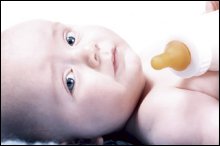Bisphenol-A: Why Makers of Toys, Medical Equipment & More Don't Want You to Worry About Bisphenol-A -- and Why You Should
by www.SixWise.com
A California Bill intended to ban certain toys, pacifiers,
baby bottles and teethers for children under 3 was recently
proposed (and defeated). The Bill sought to eliminate the
products because they can contain a chemical called bisphenol-A
(BPA) (along with some phthalates).
|

About 95 percent of baby bottles contain estrogen-mimicking
BPA, which can leach into baby's food.
|
Growing Concerns Surrounding BPA
The Bill calls attention to growing concerns surrounding
BPA and its effect on human health. The chemical is widely
used -- about 6.3 billion pounds of BPA were used in 2003
-- in a variety of products, including:
-
Tooth sealants
-
Water bottles
-
Glasses
-
Plastic liners for cans
-
Baby toys, bottles, pacifiers
-
Microwave ovenware and utensils
The problem is that BPA can leach out of plastic during everyday
use, causing health problems. Most notably, BPA mimics the
female hormone estrogen and may affect fertility and promote
cancer.
BPA Found in 95% of People Tested
"We have widespread exposure to bisphenol-A. It's in
practically everything. It's been found in blood throughout
the Northern hemisphere," said Theo Colborn, author of
"Our
Stolen Future," a book on endocrine disrupters.
According to the Centers for Disease Control and Prevention
(CDC), BPA is found in 95 percent of people tested -- a very
serious finding when you consider all the ill health effects
it has been linked to.
|

BPA is found in water bottles, cans, plastic toys and
bottles -- and 95 percent of people, according to one
study.
|
One study, published in the journal Endocrinology, for instance,
found that pregnant mice exposed to levels of the compound
similar to what a human would typically be exposed to had
alterations to the development of their mammary glands. Specifically:
-
The mammary glands of their female offspring grew in
a way that made them more susceptible to breast cancer
development.
-
The mammary glands responded unusually to estrogen, which
promotes breast cancer in humans.
-
Due to the bisphenol-A exposure, the mice were less able
to get rid of damaged cells that could be cancerous than
mice that were not exposed.
"This is of tremendous concern because this is clearly
a study that is relevant to human exposure levels to this
chemical," said Professor Frederick vom Saal, a developmental
biologist at the University of Missouri-Columbia.
Other studies in mice have found BPA exposure causes other
concerning changes as well:
-
Enlarged prostates
-
Genital deformities
-
Disrupted
puberty
-
Increased cancer rates in certain organs and cell lines
-
Pancreatic changes that promote insulin resistance
-
Pubescent mammary gland developmental changes
-
Altered to thyroid regulation
-
Structural damage to the brain
-
Hyperactivity
-
Abnormal sexual behavior
-
Increased fat formation
-
Down's syndrome
-
Disrupted reproductive cycles
"Since these substances are known to disrupt in animals,
it's hard to imagine they wouldn't in humans," said Colborn.
Industry Paints a Different Picture
When Professor vom Saal reviewed 115 studies about bisphenol-A,
he found that more than 90 percent of the studies conducted
by independent scientists found adverse consequences. However,
11 out of 11 studies conducted by the chemical industry
did not.
And when asked about the potential health effects of BPA,
Lorenz Romberg, a consultant and former U.S. Environmental
Protection Agency scientist who has testified before the government
on behalf of the chemical industry, had this to say:
"When you look at this body of evidence in total, we
didn't find any evidence that there is a marked, repeatable-across-laboratories
effect that has any clear scientific standing."
|

Choosing wood toys, rather than plastic, for your infants
may minimize their BPA exposure (especially if they
put those plastic toys in their mouths.
|
Which Products Contain BPA, and How do I Avoid Them?
Plastic containing BPA may be called:
-
Polycarbonate
-
Lexan
-
Polysulfone
Though it is generally clear, it can be tinted in various
colors.
If you have young children you should be aware that BPA
is widely used in baby bottles. In fact, according to
an article in the Jerusalem Post, about 95 percent of baby
bottles on the world market are made of BPA-containing plastic.
In Israel, the Health Ministry recently advised
parents to throw away baby bottles that are over a year old,
scratched or cracked, and not use pacifiers or teething rings
that are worn out or torn.
The advisory came in response to a Japanese study that found
baby bottles release the compound, particularly when heated
(such as during bottle sterilization). In the study, 10 different
brands of polycarbonate baby bottles were tested, along with
other clear plastic tableware. When heated, all the products
leached bisphenol-A.
Products to Avoid
If you want to avoid products with BPA, keep in mind the
following:
-
Plastic that contains BPA carries the #7 recycling symbol.
-
Most clear plastic baby bottles and child cups are made
of BPA-containing plastic.
-
Dental sealant may leach BPA; this is being debated.
You may want to avoid dental sealants on your children's
baby teeth.
You can minimize your BPA exposure by:
-
Replacing plastic food and drink containers and utensils
with glass, ceramic or metal varieties.
-
Purchasing glass baby bottles.
-
Using baby bottles and sippy cups made of polyethylene
plastic (#1, #2, #4 recycling symbols) or polypropylene
(#5) (these are usually colored, not clear, and should
still not be heated).
-
Not using canned foods or foods wrapped in plastic.
-
Not letting children put plastic toys in their mouths.
-
Being careful with BPA-containing plastics, if you choose
to use them. This means not exposing them to heat (microwave,
dishwasher) or harsh detergents (bleach, etc.) and not
letting food or beverages sit in the containers for too
long.
Recommended Reading
Why
are More Boys than Girls Being Born?
Girls
Hitting Puberty at Younger & Younger Ages: Experts Say
Exposure to Plastics and Insecticides May be the Cause
Sources
Bisphenal-A
and Phthalates Bill in California
Every
Parent's Guide to Safer Toys and a Healthier Home
Endocrinology.
2005 Sep;146(9):4138-47.
Jerusalem
Post: Don't Use Old Baby Bottles, Ministry Warns
National
Wildlife Magazine: Your Health